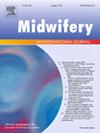The ambivalence of abortion: An explorative study on attitudes towards elective abortion and abortion limits among pregnant women in Denmark
IF 2.6
3区 医学
Q1 NURSING
引用次数: 0
Abstract
Objective
Since the legalization of elective abortion in Denmark in 1973, the abortion limit has been at gestational week 12. The abortion limit has recently been debated, leading to its extension to gestational week 18 by 2025. However, research on abortion limits is lacking in Danish and international contexts. This initial study aimed to examine Danish non-abortion-seeking pregnant women's attitudes towards elective abortion and abortion limits in Denmark, in relation to their own pregnancy and perceptions of the fetus.
Methods
This exploratory study was based on qualitative semi-structured interviews with 13 non-abortion-seeking pregnant women. All the interviews were conducted using video links. The interviews were transcribed verbatim and analyzed using thematic analysis.
Results
All participants supported abortion as a women's right. However, the responses showed a lack of knowledge about abortion procedures as well as cultural silence linked to abortion. Abortion was viewed as the responsibility and burden of women. The participants were equivocal about the placement of the abortion limit due to their own pregnancy experiences, but gestational week 12 was seen as an important milestone in securing the pregnancy and the expected child.
Conclusion
This study highlights that issues of elective abortion and abortion limits are linked to ambivalence Abortion was voiced as a woman's right, but also as a woman's responsibility, and burden. The fact that an embryo or fetus, is removed during an abortion procedure made it difficult and ambivalent for the participating women to articulate specific attitudes towards raised abortion limits.
堕胎的矛盾心理:丹麦孕妇对选择性堕胎和堕胎限制态度的探索性研究
自1973年丹麦将选择性堕胎合法化以来,堕胎限制一直是在妊娠第12周。堕胎限制最近引起了争论,导致到2025年将其延长到妊娠第18周。然而,在丹麦和国际范围内缺乏对堕胎限制的研究。这项初步研究的目的是检查丹麦不寻求堕胎的孕妇对选择性堕胎和丹麦堕胎限制的态度,与她们自己的怀孕和对胎儿的看法有关。方法对13例未堕胎孕妇进行定性半结构化访谈,进行探索性研究。所有的采访都是通过视频连接进行的。访谈内容逐字记录,并采用专题分析进行分析。结果所有与会者都支持堕胎是一项妇女权利。然而,调查结果显示,人们缺乏对堕胎程序的了解,而且在文化上对堕胎保持沉默。堕胎被视为妇女的责任和负担。由于他们自己的怀孕经历,参与者对堕胎限制的位置模棱两可,但妊娠第12周被视为确保怀孕和预期孩子的重要里程碑。本研究强调了选择性堕胎和堕胎限制问题与矛盾心理有关,堕胎被认为是女性的权利,但也被认为是女性的责任和负担。胚胎或胎儿在堕胎过程中被移除的事实,使参与的妇女对提高堕胎限制表达具体态度变得困难和矛盾。
本文章由计算机程序翻译,如有差异,请以英文原文为准。
求助全文
约1分钟内获得全文
求助全文
来源期刊

Midwifery
医学-护理
CiteScore
4.50
自引率
7.40%
发文量
221
审稿时长
13.4 weeks
期刊介绍:
Midwifery publishes the latest peer reviewed international research to inform the safety, quality, outcomes and experiences of pregnancy, birth and maternity care for childbearing women, their babies and families. The journal’s publications support midwives and maternity care providers to explore and develop their knowledge, skills and attitudes informed by best available evidence.
Midwifery provides an international, interdisciplinary forum for the publication, dissemination and discussion of advances in evidence, controversies and current research, and promotes continuing education through publication of systematic and other scholarly reviews and updates. Midwifery articles cover the cultural, clinical, psycho-social, sociological, epidemiological, education, managerial, workforce, organizational and technological areas of practice in preconception, maternal and infant care.
The journal welcomes the highest quality scholarly research that employs rigorous methodology. Midwifery is a leading international journal in midwifery and maternal health with a current impact factor of 1.861 (© Thomson Reuters Journal Citation Reports 2016) and employs a double-blind peer review process.
 求助内容:
求助内容: 应助结果提醒方式:
应助结果提醒方式:


